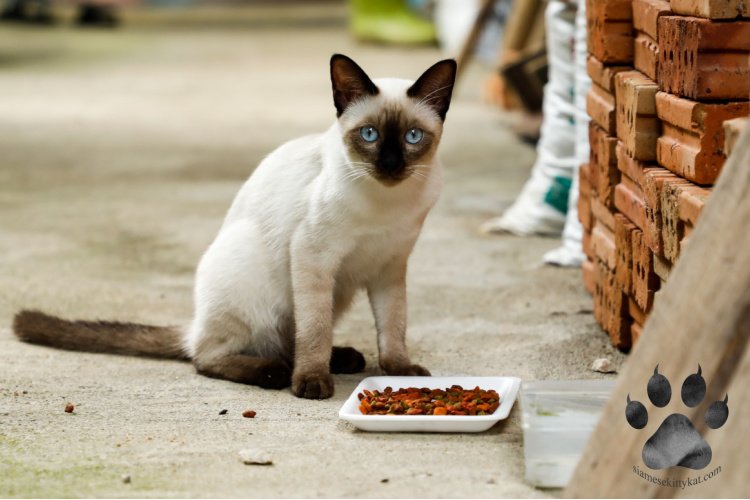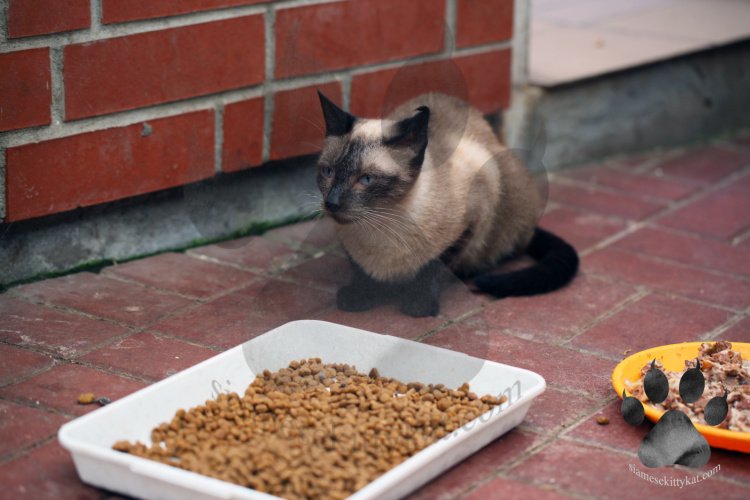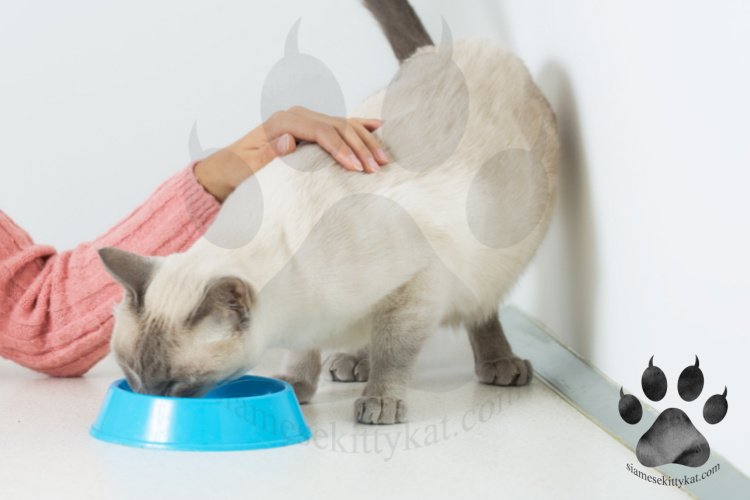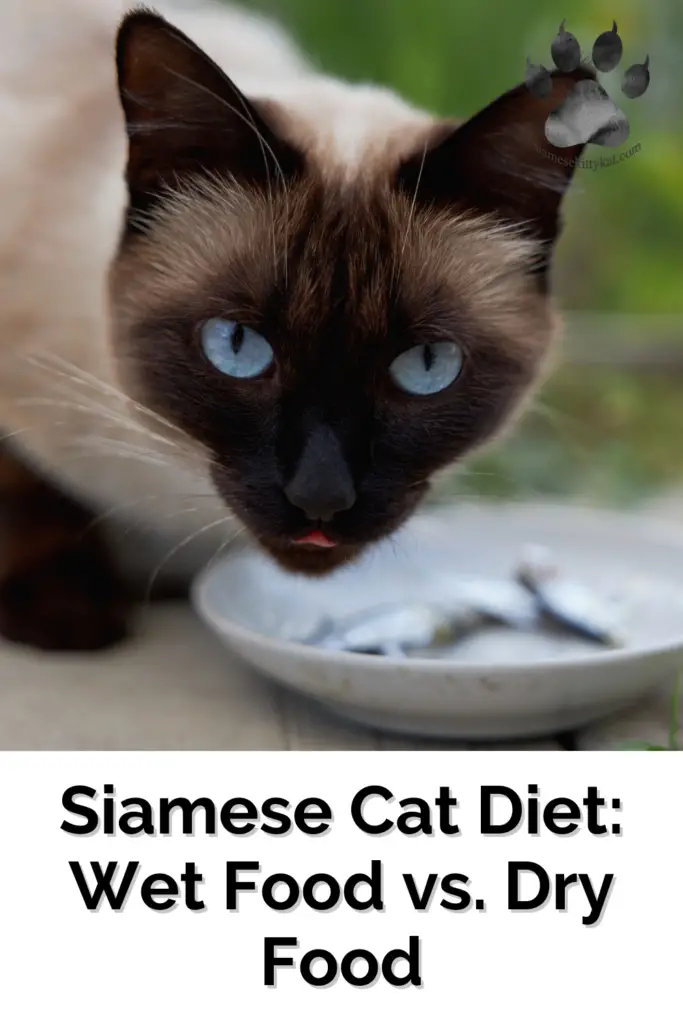I remember when I brought my first Siamese home. I had done all the research online, searched hundreds of blogs, and read tons of books. Still, I wasn’t sure that I was buying the right products, especially when it came to the food he was eating.
Now, after years of owning Siamese cats, I have somewhat mastered the art of feeding. I say somewhat because all Siamese cats are different and require different types of foods and amounts depending on their age and health.
So, I decided to write this blog today to share my personal experience on the best food for Siamese cats!
Do Siamese cats need wet food?
So, do Siamese cats really need wet food? The short answer is no; they do not need wet food to survive. In fact, there are some kitties out there who don’t even enjoy wet food and would much prefer eating dry.
That being said, feeding your Siamese wet food is a fantastic way to increase their daily water intake. In the wild, cats consume most of their water through their food, not by drinking.
The prey cats eat contains around 70-75% of water, whereas dry food only has 5-10%!
Even if your Siamese is drinking double the amount of water they usually would, they still consume less than half of what is needed.
One of the things I noticed about Batman (my Siamese) is that he doesn’t drink that much water. I tried everything I could to get him to drink more, but it turns out he’s simply not a fan.
So, I decided to introduce wet food into his diet since it’s made up of 70% moisture. Of course, this isn’t made to replace water completely, but when you have a picky kitty on your hands, sometimes wet food can help.
What are the benefits of wet cat food?
Here are a few reasons you should consider introducing wet food into your cat’s diet:
Wet food contains lots of protein, in turn supporting strong muscles. These strong muscles are maintained through adulthood, right into their senior years.
Over time, cats will naturally lose lean body mass and fat mass. Lean body mass consists of muscles, bones, organs, ligaments, and more. The organs and muscles support a ton of vital functions like mobility and immunity.
Feeding your Siamese wet food with a high protein content can support lean body mass as they age, keeping them much healthier in the long run.
If you had to eat corn all day, every day, chances are you’d get sick of it. The same goes for your Siamese! They don’t enjoy variety; they crave it.
Feeding your Siamese a diet that only consists of dry food may not be enough to satisfy their needs, even if you’re changing up the flavor.
Introducing your Siamese to wet food can open up a whole new world of new textures, tastes, and smells. You can purchase small cans or sachets of wet food, so you can try a variety to find out what they love.
In fact, if you feed your Siamese too much of the same protein and type of food, they can actually develop food intolerances and end up sick. So, it is better to switch up the proteins you are feeding them every now and again.
As I mentioned before, wet food is an excellent source of hydration.
Siamese cats may drink less water for a few reasons. The main reason is that they tend to avoid stagnant water due to the number of insects and bacteria floating around. So, this makes the still water in their cat dish a lot less appetizing.
Even if you invest in a cat water fountain, your Siamese may still feel vulnerable when drinking.
Plus, one lap of water only gives your Siamese around 3/100 of a teaspoon, which isn’t a very efficient way to re-hydrate.
But, water is still an essential part of their life. 60% of your kitty’s body is made up of water, so it’s vital they keep on top of hydration.
Introducing wet food into your Siamese cat’s life can increase that water intake by a whopping 70%, which helps improve hydration drastically.
What are the benefits of dry cat food?

Like wet food, feeding your Siamese a dry food diet also has its pros. There are millions of cats worldwide who are exclusively fed dry food and go on to live long and healthy lives!
Some dry foods can help slow down plaque accumulation or reduce tartar on your Siamese cat’s teeth. This will usually be done by mechanical scraping the tooth; however, dry food should never be an alternative to oral health and checkups.
Wet food tends to be more expensive and inconvenient compared to dry. Dry food can be left out for much longer than wet, which is essential if you are free-feeding your Siamese.
It’s easy to measure, store and has a longer shelf life.
What is the best wet food for Siamese cats?
For your Siamese to have a balanced diet, they need food that will hit all the major nutrient groups: fats and oils, proteins, carbohydrates, minerals, vitamins, and water. Unless it is specifically designed for a diet or pregnancy, good wet food will offer a balance of all.
The key ingredient you need to look for is protein (meat). It should contain at least 25% and list specific meat instead of “meat derivatives.”
Lamb, chicken, turkey, salmon, and tuna are all great sources of taurine. A taurine deficiency can lead to heart disease and blindness, which is already quite common in Siamese cats.
All other ingredients should be kept to a minimum, and they should be transparent with their levels of processing.
Fat is also an essential part of wet food. Cats should have 20 – 24 percent of fat in their diet to be considered healthy.
Buying low-fat food will not prevent weight gain or obesity; it will actually do the opposite. When cats do not receive enough fat in their food, they tend to overeat in an attempt to meet their nutritional requirements.
What is the best dry food for Siamese cats?
Since felines are obligate carnivores, most of their diet is made up of meat, including a ton of proteins and only 5% carbohydrates.
Dry food contains many more carbohydrates than wet food since they are mainly made from rice, grains, and cornmeal. Dry food can even contain proteins from vegetables, which isn’t great for your meat-loving kitty.
A diet that contains too many carbohydrates can lead to obesity and diabetes. So, you need to find a food that is high in animal fats and proteins.
The best dry food for Siamese cats will contain low carbohydrates with little or no vegetable or grain products. While it may be hard to find this, some specialty brands offer it.
When you’re next shopping for cat food, make sure you read the ingredients label and avoid ingredients such as rice, peas, potatoes, corns, and beans.
As I have mentioned, dry food contains less water than wet. So, if your Siamese prefers dry food, try adding a little bit of water to their food to help increase the water intake.
Should cats eat a mix of wet and dry food?

Yes! Unless there are specific health issues or your Siamese is sticking to a diet, mixing both wet and dry food is a great way to ensure your Siamese gets all the benefits.
All of my cats eat a wet and dry food diet. I simply measure how many grams they should be eating per day depending on their age and weight and mix two-thirds dry food and one-third wet food.
You’ll also have to consider that both types of food have a different number of calories per gram. So, you’ll want to take the weight of the dry kibble and multiply it by 2.5 to get the right amount of wet food.
How many times a day should I feed my Siamese cat?
How many times you feed your Siamese per day depends on their age and activity rate.
Since Siamese cats are incredibly active, they need enough nutrition to support their wellbeing. Each time they hit a new milestone, their food should be adjusted accordingly to support their growth and level of activity.
Do Siamese cats meow when they’re hungry?
Let’s face it; Siamese cats are one of the noisiest creatures out there. While ordinary moggies cry when they need something (food, water), Siamese cats will scream the house down just because they are bored, hence, why it can sometimes be hard to know if your Siamese is hungry or they’re just doing it for attention.
Robyn, my other Siamese, went through a phase of meowing right after being fed. He’d gobble up all his food, then follow me into the living room, where he would continue to meow nonstop.
I couldn’t figure out why; when I put a little extra in his bowl, he would turn his nose up at it. It stumped me for days; I changed his food, moved his bowl, and even kept him company while he ate, but nothing helped.
It was only a week later until I realized that his water bowl had been moved slightly. This drama queen was trying to tell me he didn’t like the angle of his bowl after every mealtime!
If you feed your Siamese every time they meow, and they don’t reject it as my Robyn does, they’ll be on a quick road to obesity.
If you’re feeding them the recommended amount per day and they’re still meowing, cover all possible causes. If you can’t pinpoint the reason, take a trip to the vets where they can give your Siamese a quick checkup to see if all is good.
How should I feed my Siamese?

There are two methods in which you can use to feed your Siamese: free feeding and scheduled feeding.
Personally, I choose to feed my Siamese cats on a schedule. I do this for a few of reasons:
Of course, this is something that works for my family and me. All cats are different, and some may prefer picking at their food when they like instead of eating a meal in one go.
Experiment with your Siamese and see what works best for them.
Free Feeding
Free feeding your Siamese means that their food is always available. You can only do this with dry food since wet food is made to be consumed once opened.
If your Siamese leaves food in the bowl for more than one day, you should throw it out and fill the bowl with fresh food.
Pros:
Cons:
If you don’t manage the amount of food you give your Siamese, free-feeding can easily lead to obesity.
To tackle this, measure how much food they should be consuming per day. Once the food for a day is gone, don’t fill the bowl back up. This’ll let your Siamese know that they should pace themselves while eating, or they will have to wait for tomorrow to be fed again.
A friend of mine swears by food puzzles. She has a domestic shorthair that devours her food that she throws up afterward. While most people use food puzzles for rewards and a form of mental stimulation, they can also be an excellent help for cats who gobble up their food too quickly or overeat.
Scheduled Feeding
Scheduled feeding is allocating a specific time of day to feed your Siamese. You can use both dry and wet food for this method.
Pros:
Cons:
Should I give my cat wet or dry food?
At the end of the day, what you feed your Siamese has a lot to do with what they prefer.
If your Siamese doesn’t like to eat wet food, that’s fine. As long as they’re not consuming too many carbohydrates and they drink enough water, there is no reason why you should change their diet.
If your Siamese enjoys exclusively eating wet food, there is also nothing wrong with this. As long as they are eating enough proteins and you’re regularly brushing and caring for their teeth (you should do this even if they’re eating dry), then all is fine.
Of course, the best solution would be a mix of both wet and dry. This way, your Siamese can have the best of both worlds while still staying happy and thriving!
We gathered all the health tips tailored toward maintaining your Siamese cat’s optimal well-being. Check it out here: Siamese Cat Health: A Complete Guide
Get your FREE Siamese Cat 2024 Printable Calendar


